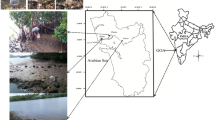Abstract
Background
Under anoxic conditions typically prevailing in disposal sites for dredged sediment, methanogenesis is the terminal step during microbial degradation of sediment organic matter. Sediment gas production may pose several problems to site management and post-closure utilisation. Depending on the magnitude of gas/methane formation and the intended utilisation of the site, countermeasures will have to be effected during and after deposition of the dredged material. For this purpose it may be of interest to pre-estimate the extent of gas formation from simple sediment variables. Therefore, the aim of the investigations presented here was to analyse the interrelations between gas formation and sediment physical, chemical and biological qualities.
Methods
Freshly sampled riverbed sediment from nine German federal waterways was analysed for standard solid physical and chemical parameters, pore water composition, cell counts of methanogenic and sulfate-reducing bacteria, and gas formation over a period of 500 days. Particle size and density fractionation were carried out in order to characterise organic matter quality. Correlations between methane formation and sediment chemical, physical and microbiological characteristics were tested using linear and multiple correlation analysis.
Results and Discussion
The selected sediments, including two with marine influence, differed strongly regarding texture, chemical parameters, pore water composition, and methanogen cell counts. The course of methane formation was found to follow distinct phases. The commencement of methane formation was preceded by a lag phase of variable duration. The lag phase was followed by a strong increase of the methane formation rate up to a sediment-characteristic maximum of 5–30 nmol CH4 h–1 g dw–1. Eventually, the rate of methane formation decreased and reached a more stable, long-term level. The extent and amplitude of each phase varied strongly between sediments and could be correlated well with only a few standard analytical parameters, despite the strong heterogeneity of sediment with respect to chemical, physical, and biological characteristics. Lag phase duration depended strongly on the content of inorganic electron acceptors and also on the number of methanogens present at the beginning of the experiment. Maximum and steady state methanogenesis were mainly determined by sediment total nitrogen. As analysis of sediment density fractions revealed that total nitrogen reflected the share of readily degradable macroorganic matter.
Conclusion and Outlook
The results imply that the observed methane formation is a function of the temporally changing balance of the availability of electron acceptors and H2, and the share of easily degradable organic matter. For fresh riverbed sediments, the latter may be deduced from total nitrogen content. Overall, the results showed that methane formation by freshly dredged material may well be pre-estimated from standard analytical data within the first few years of deposition. However, the differently degradable organic matter pools will change over time with respect to size, chemical nature and association with the sediment mineral phase. It can thus be expected that the correlations found in this study will not be readily transferable to older materials. Further studies on the gas formation and organic matter quality by older sediments, e.g. from older dredged material disposal sites of known age, should be conducted and results should be combined with existing organic matter degradation models in order to improve the prediction of sediment gas formation over time.
Similar content being viewed by others
Author information
Authors and Affiliations
Corresponding author
Rights and permissions
About this article
Cite this article
Gebert, J., Köthe, H. & Gröngröft, A. Prognosis of Methane Formation by River Sediments (9 pp). J Soils Sediments 6, 75–83 (2006). https://doi.org/10.1065/jss2006.04.153
Received:
Accepted:
Published:
Issue Date:
DOI: https://doi.org/10.1065/jss2006.04.153




